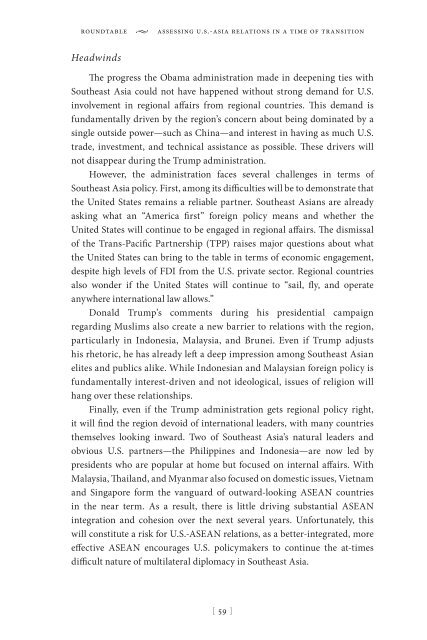2jBVKVf
2jBVKVf
2jBVKVf
You also want an ePaper? Increase the reach of your titles
YUMPU automatically turns print PDFs into web optimized ePapers that Google loves.
oundtable • assessing u.s.-asia relations in a time of transition<br />
Headwinds<br />
The progress the Obama administration made in deepening ties with<br />
Southeast Asia could not have happened without strong demand for U.S.<br />
involvement in regional affairs from regional countries. This demand is<br />
fundamentally driven by the region’s concern about being dominated by a<br />
single outside power—such as China—and interest in having as much U.S.<br />
trade, investment, and technical assistance as possible. These drivers will<br />
not disappear during the Trump administration.<br />
However, the administration faces several challenges in terms of<br />
Southeast Asia policy. First, among its difficulties will be to demonstrate that<br />
the United States remains a reliable partner. Southeast Asians are already<br />
asking what an “America first” foreign policy means and whether the<br />
United States will continue to be engaged in regional affairs. The dismissal<br />
of the Trans-Pacific Partnership (TPP) raises major questions about what<br />
the United States can bring to the table in terms of economic engagement,<br />
despite high levels of FDI from the U.S. private sector. Regional countries<br />
also wonder if the United States will continue to “sail, fly, and operate<br />
anywhere international law allows.”<br />
Donald Trump’s comments during his presidential campaign<br />
regarding Muslims also create a new barrier to relations with the region,<br />
particularly in Indonesia, Malaysia, and Brunei. Even if Trump adjusts<br />
his rhetoric, he has already left a deep impression among Southeast Asian<br />
elites and publics alike. While Indonesian and Malaysian foreign policy is<br />
fundamentally interest-driven and not ideological, issues of religion will<br />
hang over these relationships.<br />
Finally, even if the Trump administration gets regional policy right,<br />
it will find the region devoid of international leaders, with many countries<br />
themselves looking inward. Two of Southeast Asia’s natural leaders and<br />
obvious U.S. partners—the Philippines and Indonesia—are now led by<br />
presidents who are popular at home but focused on internal affairs. With<br />
Malaysia, Thailand, and Myanmar also focused on domestic issues, Vietnam<br />
and Singapore form the vanguard of outward-looking ASEAN countries<br />
in the near term. As a result, there is little driving substantial ASEAN<br />
integration and cohesion over the next several years. Unfortunately, this<br />
will constitute a risk for U.S.-ASEAN relations, as a better-integrated, more<br />
effective ASEAN encourages U.S. policymakers to continue the at-times<br />
difficult nature of multilateral diplomacy in Southeast Asia.<br />
[ 59 ]


